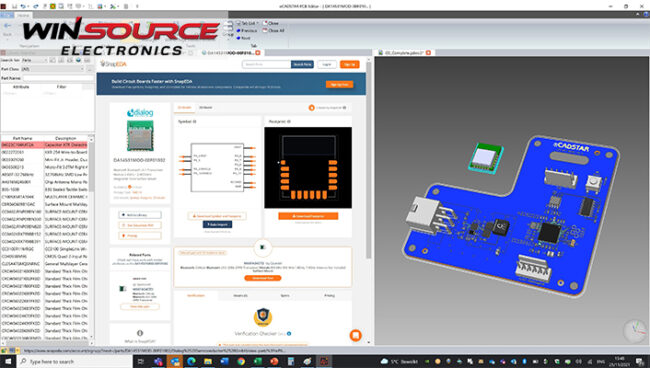
Designing is the foundation of the engineering world. Whether it is building structures, creating machines or developing technology, design plays a crucial role in bringing ideas to life. In the field of electronics and circuit design, engineers are constantly seeking ways to improve their skills and optimize their designs.
Fortunately, with the advancements in technology and software tools, engineers now have access to an array of powerful circuit design tools that empower them to create efficient and high-quality designs. This article sheds light on three of the ultimate circuit design tools – CircuitMaker, Protolab and SnapEDA.
Let’s learn how they are revolutionizing the way engineers approach circuit design.
1. CircuitMaker 2.0:The Creative Freedom
CircuitMaker serves as a beacon of innovation, offering engineers unprecedented freedom in circuit design. With support for up to 16 signal layers and 16 plane layers, CircuitMaker allows engineers to craft intricate designs without being constrained by arbitrary limitations on PCB dimensions.
Notably, the absence of a “non-commercial” clause opens doors for engineers to monetize their designs without any restrictions.
Key Features of CircuitMaker:
Massive Rich Component Library: CircuitMaker has an extensive component library, equipping engineers with a vast array of options for their designs. Offering basic resistors to complex integrated circuits, the rich library facilitates efficient and diverse circuit creation.
Native 3D Support: The integration of native 3D capabilities elevates the design experience. Engineers can visualize and analyze their circuits in three dimensions, enhancing accuracy and aiding in the identification of potential issues before the fabrication stage.
Share and Collaborate: CircuitMaker embraces collaboration with features that allow engineers to share their projects seamlessly. With the ability to decide whether to share designs with the entire community, specific authors, or customers, engineers have control over the visibility of their work.
Push-N-Shove Routing: This advanced routing feature optimizes the layout of traces on the PCB, minimizing signal interference and ensuring efficient signal propagation. The push-n-shove functionality streamlines the routing process, enhancing overall design productivity.
Multi-Sheet Schematic Editor: Complex designs often require a modular approach. CircuitMaker’s multi-sheet schematic editor enables engineers to organize and manage intricate schematics more effectively, enhancing overall project clarity and comprehension.
Topological Autorouter: Automation is key in complex designs, and CircuitMaker excels with its topological autorouter. This feature intelligently determines optimal trace routes, reducing manual effort and minimizing the risk of errors.
DRC/DFM Validated Outputs: Design Rule Check (DRC) and Design for Manufacturability (DFM) are critical aspects of the design process. CircuitMaker validates outputs against these rules, ensuring that the final design is not only functional but also manufacturable without complications.
2.Protolab 4.0: Seamless Circuit Design With Intuitive Interface
Protolab 4.0 stands out for its user-friendly interface, enabling engineers to create AC and DC circuits effortlessly. The tool’s “click & drag” component placement and on-line help make it an ideal choice for both novice and experienced engineers, offering a quick learning curve and efficient circuit creation.
Key Features of Protolab 4.0:
Easy-to-Use Interface: Protolab’s interface is designed with simplicity in mind. The “click & drag” component placement ensures a straightforward and intuitive circuit design process, allowing engineers to focus on the creative aspects of their projects.
Active and Passive Component Selection: A comprehensive list of active and passive components empowers engineers with the flexibility to choose the right elements for their designs. This extensive library covers the spectrum of electronic components, ensuring that engineers have the tools they need at their fingertips.
Virtual Instruments: Protolab includes five virtual instruments for instant and accurate circuit analysis. These instruments provide real-time feedback, allowing engineers to assess the performance of their circuits and make informed decisions during the design phase.
Pre-Designed Circuit Library: To further expedite the design process, Protolab comes equipped with a pre-designed circuit library. Engineers can leverage these pre-existing circuits as building blocks, saving time and effort while maintaining design integrity.
3.SnapEDA: Accelerating Design with Ready-Made Components
SnapEDA plays a crucial role in the circuit design ecosystem by providing engineers with a vast repository of ready-made components. This platform streamlines the design process by offering high-quality, verified components that can be seamlessly integrated into various design tools, including CircuitMaker and Protolab.
Key Features of SnapEDA:
Component Libraries: SnapEDA hosts an extensive collection of component libraries, encompassing a wide range of electronic components. Engineers can easily search for and find the components they need, eliminating the need for manual creation and verification.
Integration with CircuitMaker and Protolab: SnapEDA’s compatibility with popular circuit design tools such as CircuitMaker and Protolab ensures a smooth transition from component selection to design implementation. Engineers can seamlessly import SnapEDA components into their projects, saving valuable time and reducing the likelihood of errors.
Quality Assurance: SnapEDA places a strong emphasis on component quality and reliability. Each component undergoes rigorous verification processes to ensure accurate footprints, symbols, and 3D models. This commitment to quality mitigates the risk of design errors related to incorrect or poorly verified components.
Overall, these three circuit design tools – CircuitMaker, Protolab and SnapEDA – are truly empowering engineers to bring their ideas to life with ease and efficiency. From a free community-driven tool like CircuitMaker to the seamless integration of components in Protolab and the vast library of parts in SnapEDA. These tools provide engineers with all the necessary resources for successful circuit design.
And to top it off, WIN SOURCE serves as an excellent distributor for electronic components, making the process of sourcing parts even more convenient. With these tools and resources at their disposal, engineers can confidently take on any circuit design challenge and bring innovative ideas to reality

COMMENTS